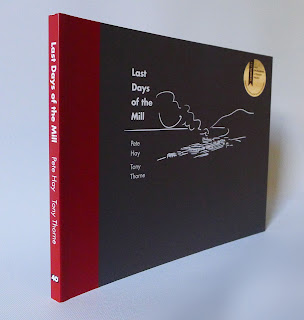Originally published
here.
Review – Last Days of the Mill by Pete Hay
by Sally Oakley
Fierce parochialism is a Tasmanian tradition. To mainland Australians, this can seem extraordinary. How can an island so small remain so divided within itself? Do southerners really refuse to drink ‘northern beer’, as I once joked at a BBQ in Victoria?
As I sat down to read Last Days of the Mill, I did so as a Hobart-born woman now living in Launceston. An hour-and-a-half’s leisurely drive from Burnie, yet so far away. If I needed any reminder that I’m clueless about the life of Burnie’s mill-workers, I found it by the first page.
Pete Hay undertook a writer’s residency in Burnie during 2010-2011, using the time to research and interview workers of Burnie’s (now closed) Pulp Mill. His resulting poetry is uniquely stunning.
In his notes about the poems, Hay is at pains to stress the intrinsic value of vernacular language. He supports the idea that ‘the word in the air is not the same word on the page’.
…The task is to do justice to non-literary speech in a manner that avoids condescension and does not result in the substitution of the superficially quaint for the real dignity of the speaker and the communicative complexity of his/her message. [p. 98]
Comprehensively achieving Hay’s objective, the poems present richly varied, complex characterisations. The book is steeped in the ambivalence so characteristic of humans reflecting on events past. Nuanced and flowing, the narrative is both compelling and unfamiliar.
The people Hay interviewed are ‘skilled communicators, their vocabularies large and richly deployed, their recourse to metaphor and simile inventive’ [p.98]. Hay has used some of this metaphorical speech as titles for the ten poems. Just a glance at the list of poems is enough to excite anyone interested in words. ‘Clean as a Peeled Egg’, ‘Slow as an Old Wet Week’ and ‘Christmas on a Stick’ sit alongside ‘Crook as Maggoty Mutton’, ‘Shit Sandwich’ and ‘Th Duck’s Guts’. So fresh are these titles, I wondered if the poetry itself would disappoint with impenetrability. It didn’t.
Hay is a tale-weaver. He has an eye for political controversy, but Hay lets those closest to the drama tell the story. This is not an editorialised agenda-driving book. In style it is in fact closest to oral history.
Accompanying Hay’s poems is artwork from Tony Thorne. Thorne ‘learned to draw on the Burnie Bond paper my grandfather would bring us from the Mill’ [p. 101]. Arriving at the Burnie Mill in June 2010, Thorne captured some of the last hours of operation. Sketching fast as well as taking photographs, it is clear that Thorne was moved by the Mill’s imminent closure:
The Mill was always there, from way before I was born. Its hum rumbled through the steep valleys of Burnie. [p. 101]
Nowhere in Tasmania has a town’s existence been more entwined with a factory than Burnie and the Paper Mill have been. For many decades it linked every person. [p.103]
This view is emphatically supported by the voices of the people in Last Days of the Mill.
Not just the men, either. As well as observing some of the working conditions at the Pulp Mill, Last Days of the Mill homes in on the strike of 1992. Hay has interviewed people from differing viewpoints – the strikers and their spouses, the ‘scabs’ who defied the strike and went to work, the security officers – they’re all here in detail. This is not a book that comprehensively explores the delicate (or indeed indelicate) political wrangling surrounding the strike. But it certainly doesn’t deny the context.
Pete Hay's Last Days of the Mill
The voices are strong, whether talking about the Mill, the weather, or the picket lines. There are loyal statements – ‘we was a pulp family from way back’ (p.24) – and camaraderie: ‘the picket brings y’close t’people’ (p.26). There are affectionate remembrances at every turn: ‘She’s a thing, this picket’ (p.25). There is excitement, danger and hope. Sentimentality about employment conditions – ‘Th old Pulp was good to us’ (p.28) – contrasts with details about the risks involved in mill work. Tales of injuries to send you queasy, reference to retirement health problems; all this is relayed through the voices Hay has captured.
As a child I can remember visiting Burnie, thinking of it as a dark, smelly, polluted place because of the Mill. I had no concept of the social implications of the Mill’s presence – I only knew that it was a polluter, a tree-eater, and therefore a ‘bad thing’. Last Days of the Mill has given me a broader perspective.
Yet it wasn’t written for the likes of me. It is in some respects a tribute to the people of Burnie. Not that the Burnie community doesn’t have an identity anymore – but it is different now. Last Days of the Mill, in Pete Hay’s own words, is a testament ‘to the generous and large-hearted ‘pulpies’ of Burnie who provided the stories and the ways of strong Tasmanian speech that I have striven to valorise’ [p. 99].
Last Days of the Mill is a spectacular rendering of some important Tasmanian voices. Innovatively constructed, evocative and delightful, it will be widely read and treasured.■
Last Days of the Mill
Poems by Pete Hay, illustrations by Tony Thorne
Forty South Publishing
ISBN 9780987283863























